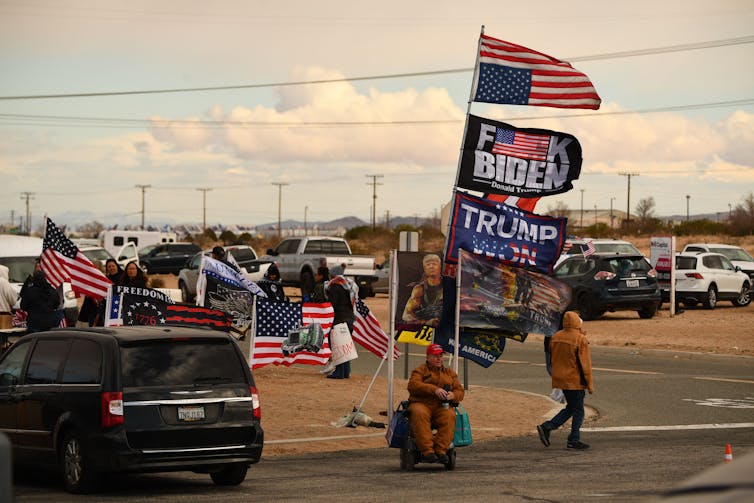The role party affiliation played in getting US to grim new milestone of 1 million COVID deaths
Your willingness to get a vaccination is tied to your political party. And that may have deadly consequences.

COVID-19 has now claimed the lives of 1 million Americans – a grim milestone made worse by the fact that probably a third of those fatalities could have been avoided. Estimates suggest that more than 318,000 deaths from the disease occurred among individuals who had access to vaccines, but chose not to receive any.
With such a devastating pandemic sweeping the country, and the globe, why would so many Americans forego a potentially life-saving vaccine?
One key answer to this question is – as with much in the U.S. today – partisan politics.
Since vaccines for COVID-19 first became available, polls have consistently shown that Republicans are much less likely than Democrats to be vaccinated or to want to be vaccinated. According to monthly surveys conducted by the Kaiser Family Foundation, this partisan gap has averaged more than 30 percentage points between May 2021 and April 2022.
But the story is both more complicated and wide-ranging than it first appears. We know that party and ideology account for many of the differences in the lives of Americans.
Our research finds that not only is party affiliation a powerful predictor of vaccine willingness, it also contributes to other attitudes that promote or inhibit willingness to be vaccinated, giving it added power.

The pull of partisanship
In two surveys we conducted in March and June of 2021, we found that party affiliation affected COVID-19 vaccination preferences independently of some of the standard influences such as education, age and race. That means party alone can help determine whether a person got a vaccination.
What we also found, however, is that partisanship has additional effects on vaccination status and willingness. That’s because it contributes to other factors that also affect willingness to get vaccinations, and so contributes “indirectly” to willingness as well as directly.
These indirect factors included the impact of partisanship on one’s concern for contracting COVID-19 oneself; concern for others contracting it; trust in government; trust in scientists and medical professionals; and conspiracy theories surrounding the vaccine – namely that the vaccine would insert a tracking microchip into the body and that it could cause sterility.
Party affiliation influenced Americans’ attitudes in each of these areas, which in turn affected a person’s willingness to get a COVID-19 vaccine. This basically multiplies the effect that party affiliation has over vaccinations.
Vaccine divide
Republicans and Democrats haven’t always felt this differently about potentially life-saving vaccines.
A review of historical public opinion trends during other health crises shows that in 1954, Republicans were roughly equally as likely – only 3 percentage points less – as Democrats to say they were willing to get the then-new polio vaccine.
The vaccine hesitancy gap between the parties for the Asian flu vaccine in 1957 was somewhat larger, but still a far cry from today’s gap – Democrats were 9 points more likely to get that vaccine. For the swine flu vaccine in 1976, Democrats were 4 points more likely to get the vaccine.
But since 2000, there have been double-digit partisan gaps in willingness to accept other vaccines to address public health crises. When the administration of George W. Bush raised the possibility of reintroducing the smallpox vaccine in 2002, Republicans were 11 points less likely than Democrats to say they would get the vaccine. During the swine flu pandemic in 2009, this difference grew to 15 points. Most recently, initial reaction in a July 2020 Gallup Poll to the promise of a new COVID-19 vaccine produced a gap of 34 points: 81% of Democrats said they were likely to get the vaccine compared to just 47% of Republicans.
While there is no way to definitively tell if Republicans are dying from COVID-19 at higher rates than Democrats as a result of these discrepancies, there are numbers that suggest it. An ABC News analysis shows that after vaccines became readily available, states that voted for Donald Trump in 2020 had an average of 38% higher death rates due to COVID-19 than states that voted for Joe Biden.
The partisan difference in vaccine hesitancy can be traced to a broader change in each party’s attitudes toward science.

What happened?
Polling data shows that throughout the 1970s and 1980s, Republicans were consistently more likely than Democrats to report a great deal of confidence in the scientific community.
In the mid-1980s, however, prominent Republican leaders began to publicly disparage scientific input on public policy issues – initially about the acid rain debate, then expanding to other topics.
Over time, these messages discrediting science and scientists’ opinions on public policy affected public opinion within the parties.
In the early 2000s, the parties began to switch positions. Since 2008, Democrats have consistently displayed greater confidence in science, with the largest gap on record – 30 percentage points – occurring in the most recent survey measuring it, in 2020.
The path from broader distrust in science to hesitancy toward vaccines may have a long history, but it is fairly straightforward. Scientists are the ones who research and develop vaccines, while scientifically trained doctors and nurses administer them. The most prominent talking heads in the media advocating for vaccination are from the scientific community – including, most notably, Dr. Anthony Fauci. Based on years of rhetoric from party leaders, Republican voters were already primed to distrust these figures.
Our own research demonstrates that citizens who distrust scientists and who distrust medical professionals are less likely to be vaccinated and show less willingness to consider doing so in the future.
Since these tendencies are now more prominent in the Republican Party than in the Democratic Party, this helps drive the overall partisan gap in COVID-19 vaccination and death rates among red and blue states.
Even as COVID-19 seems to be becoming less deadly, experts warn that it is not the last viral pandemic we will face.
Elected officials and other policymakers planning for future threats would be wise to keep in mind the depth of the ongoing partisan divide on vaccination.
For example, while state and federal officials made a point of doing specialized outreach to boost COVID-19 vaccination rates in low-income communities and communities of color, specialized outreach may also be appropriate on the basis of partisan affiliation. Furthermore, such outreach needs to consider that a prominent hurdle to overcome among Republicans is a deficit in trust in medical professionals specifically – and science more generally.
Monika L. McDermott is affiliated with brilliant corners Research and Strategy as a consultant.
David R. Jones does not work for, consult, own shares in or receive funding from any company or organization that would benefit from this article, and has disclosed no relevant affiliations beyond their academic appointment.
Read These Next
The world risks forgetting one of humanity’s greatest triumphs as polio nears global eradication − 7
Polio may finally be defeated in the next 5 years. Will the world recognize what an extraordinary achievement…
People are getting their news from AI – and it’s altering their views
Even when information is factually accurate, how it’s presented can introduce subtle biases. As large…
Medieval peasants probably enjoyed their holiday festivities more than you do
The Middle Ages weren’t as dreary and desperate as you’d think, and peasants often had weeks of…





